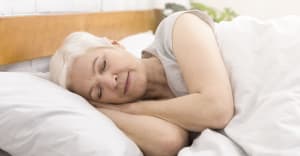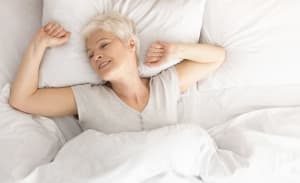
In the United States, the average adult will have spent over 36 years sleeping by the end of their life. That’s more than one-third of the average human lifespan. Of course, this isn’t because we’re lazy, or particularly like sleep (though most do). Sleep is essential for living a healthy life, from birth until death. It provides us with a space to grow, rest and replenish our body and minds. But as we age our sleep needs change. The amount of sleep we need, and the reasons we need it, ebb and flow with the changes our body undergoes during the natural aging process.
Sleep patterns are intricately linked with aging. So too are the obstacles we will face getting the appropriate amount of sleep at each stage in our life. Keep reading to learn how our sleep patterns change with age, and how to ensure you are getting a healthy amount no matter how old you are.
Age and the sleep cycle
As you may know, sleep is not a homogenous process, but a series of different processes known altogether as the sleep cycle. When we sleep, our body cycles through these discrete stages many times throughout the course of a night, spending different amounts in each according to the needs of the body.
There are essentially two main kinds of sleep: rapid eye movement (REM) and non-rapid eye movement (NREM).
- NREM:NREM can be divided into several stages. During stages 1 and 2 of NREM, also called “light sleep,” our body relaxes physically. These stages occur right after we fall asleep. Stages 3 and 4 of NREM are called “deep sleep,” and they are marked by increased muscle relaxation as your body repairs its tissues and cells. Many call deep sleep the healing stage.
- REM: During REM sleep our body becomes almost entirely physically inactive, except for our eyes, which twitch back and forth. This is because our brains are very active in working to process memories and sort information. Our body paralyzes in order to stop us from acting out the vivid dreams that accompany this process.
As we age and the needs of our body change, we will need different amounts of each of these types over time. A healthy sleep habit or an older adult will consist of a much different ratio of stages than for an infant. For example, young children can spend up to 50% of their time in REM sleep, whereas adults spend just about 20% of their time there. Furthermore, adults typically spend the majority of their time in light sleep stages, while children hardly spend any time there at all. Adults typically cycle through all of the stages in about 90 minutes. For children, this process takes about 45 to 60 minutes.
Sleep at each age
Many factors contribute to how much sleep any given person should get at any given point. But generally speaking, scientists have worked out a basic trajectory for how our sleep needs change as we age. Note that next to each age group we’ve listed the amount of sleep recommended by the National Sleep Foundation.
Newborns (0-3 months):
recommended hours: 14 to17 hours per day
Newborns will sleep sporadically (as new parents know), often splitting up their hefty sleep needs into several stretches during the day and night. At this age, newborns spend about half of their time in REM sleep, which has been linked to brain development. They will also spend a significant amount of time in NREM deep sleep, which is linked to physical development.
Infants (4-12 months):
recommended hours: 12 to 17, including naps
After three months, infants might begin sleeping 6 to 8 hours during the night and take a few short naps during the day. They will still spend much of their time in REM and deep sleep as they are experiencing rapid growth and development.
Toddlers (1-2 years):
recommended hours: 11 to 14, including naps
Toddlers will begin to reduce their sleep time during the day to a single nap that can last between 1 to 3 hours typically. During this time, the circadian clock that syncs the body’s sleep patterns with the night and day cycle begins to develop significantly.

Preschoolers (3-5 years):
recommended hours: 10 to 13, including naps
Preschoolers will still nap during the day, but those naps will likely be shorter than an hour or so. Children at this age will no longer spend half of their time in REM sleep, but still spend the majority of their time split between deep sleep and REM.
School-age children (6-12 years):
recommended hours: 10 to 12
By this age, children will likely be getting their sleep needs in a single block of time during the night, without needing naps during the day. This is also the age at which sleep disturbances can begin to affect people.
Teenagers (13-18 years):
recommended hours: 8 to 10
Interestingly, teenagers generally have a well-developed circadian system that is simply delayed by a few hours. The result is that most people this age tend to rise and fall asleep later than the average adult. Most teenagers will not get the recommended amount, and it inevitably will affect their mood, productivity and energy levels.
Adults (18-64 years):
recommended hours: 7 to 9
The brain and body continue to develop until about age 25, though this age group requires less sleep than adolescents. By this time the body has adjusted its sleep cycle to the typical ratios and lengths of the adult sleep cycle, spending most of the time in light sleep NREM.

Older Adults (65 years+):
recommended hours: 7 to 8
Older adults typically need the least amount of sleep compared to any other age group. They are also the most likely to suffer from sleep disorders such as sleep apnea, restless legs syndrome and periodic limb movement disorder.